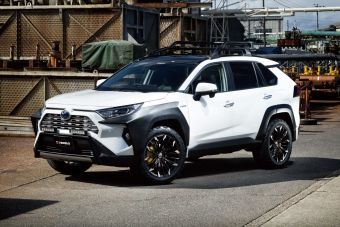
On the sled of war — Toyota RAV4
Usually we take cars for testing a little randomly - there is a new car, it needs to be checked. This time I chose an older car, but rather deliberately. I was going skiing and I needed a machine that could handle snowy climbs and roads that weren't always snow-free.
The Toyota RAV4 is one of the most popular vehicles in the small SUV segment. Despite the fashion to make cars of this type look like hatchbacks or vans, the RAV4 still has the appearance of a smaller SUV, albeit with somewhat softened lines. In a recent upgrade, the car received a stronger grille and headlights reminiscent of those of the Avensis or Toyota Verso. The car has a fairly compact silhouette. Its length is only 439,5 cm, width 181,5 cm, height 172 cm, and wheelbase 256 cm. Despite its compact size, it has a fairly spacious interior. Two men taller than 180 cm can sit one after the other. In addition, we have a luggage compartment with a capacity of 586 liters.
The most characteristic element of the car interior is the dashboard, divided by a horizontal groove. Stylistically, this is perhaps the most controversial element of the car. I like it in part - in front of the passenger it made it possible to create two compartments. The top is quite flat, but wide, opens and closes with one touch of a large convenient button. I love it. The center console is much worse. There, the furrow separating the board is also associated with functional separation. In the upper part there is an audio system, and in the test car there is also satellite navigation. At the bottom are three round regulators for two-zone automatic air conditioning. Functionally, everything is fine, but the design somehow did not convince me. The rear seat is three-seater, but the separation of the seats, and most importantly, the not very convenient fastening of the central three-point seat belt, suggests that the optimal number of people sitting in the back is basically two. The functionality of the rear seat is enhanced by the possibility of its movement, and comfort - by adjusting the backrest. The sofa can be folded to form a flat luggage compartment floor. It's quick and easy, especially since the tie-downs in the trunk wall allow you to do it on the side of the trunk as well.
Skis are best carried in a roof box, but buying one for a car that I have for a few days is rather wasteful. Luckily, the car has a fold-down armrest in the back seat, allowing you to store your skis inside. Sometimes I also used a magnetic holder, which held up very well despite the slight roof ribbing. The tailgate opens to the side, so there is no risk that the sliding hatch will catch on the skis pushed too far back and get scratched. Skis or snowboards up to 150 cm long fit easily into the trunk, which has a capacity of 586 liters as standard. Small items that we want to protect from this moisture will find a place in a fairly spacious compartment under the boot floor. We also have a small net on the door and hooks for hanging bags on the cabin walls. I also really needed a wide threshold on the rear bumper - it was convenient to sit on it and change shoes. Despite the automatic transmission, riding in ski boots is unlikely to succeed.
The Toyota we tested was equipped with a Multidrive S automatic transmission. It has six gears and two clutches, making the shift network almost invisible. This can be seen after changing the speed of rotation, but the point is in the readings of the tachometer, and not in the feeling of a jerk or an increase in noise in the cabin. However, I must admit that after combining the 158-horsepower engine (maximum torque 198Nm) and the dual clutch gearbox, I expected more dynamics. Meanwhile, in stock settings, the car accelerates very conservatively. For more dynamic driving, you can use the Sport button to increase engine speed and change gears at higher rpm. Another option is manual shifting in sequential mode. Already shifting the gearbox from automatic to manual causes a significant increase in engine speed and downshift, for example, when we change the mode of the gearbox while driving in seventh gear, the gearbox shifts to fifth gear. Sport mode allows for satisfactory acceleration, but comes at the cost of significantly higher fuel consumption. According to technical data, the car accelerates to 100 km / h in 11 seconds, and its maximum speed is 185 km / h. Several days of driving in the mountains, where I tried to be as economical as possible, resulted in an average fuel consumption of 9 liters (average from the technical data 7,5 l / 100 km). At that time, the car had to cope with fairly long steep climbs in the snow. Automatically controlled all-wheel drive worked flawlessly (using the button on the dashboard, you can turn on the constant distribution of the drive between both axles, useful when driving in deeper mud, sand or snow). In tight corners, the car leaned back a bit during climbs. The weather was kind to me, so I did not have to resort to the support of the electronic hill-descent control system on slippery slopes, which, by maintaining a low speed and braking individual wheels, should prevent the car from turning on its side and tipping over. The advantage of automatic transmission is also the ease with which the car moves uphill, which is very important on slippery surfaces.
Pros
Compact size
Roomy and functional interior
Smooth gearbox operation
Cons
Uncomfortable rear seat belts
Less dynamic than I expected